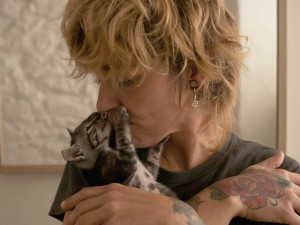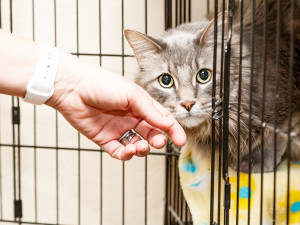Get the Inside Scoop on Adoption Applications
Ready to take the plunge? Here’s everything you need to know about applying to adopt a pet.
Paperwork and pets might each fall on opposing ends of the happiness scale but, unfortunately, one is necessary for the other. When adopting from a shelter or rescue organization, one of the first things you’ll need to do is fill out an application. Once approved, an interview with an adoption counselor often follows. If you feel the way most do about administrative tasks and interviews, this is probably not great news — but that’s okay. We’re here to prep you so the process goes as smoothly as possible.
Every organization’s application process and questions are a little different, but they all serve the same purpose: making sure you get a pet who fits your lifestyle and the pet gets the home they deserve. We did a little digging to uncover common application and interview questions. Then we chatted with Sam Ellingson, Associate Director of Marketing and Communications at Humane Society for Southwest Washingtonopens in new tab, to learn the goals of some of those questions. With that, let’s start applying like a recent college graduate.
Adoption Application
Some organizations have a single application that can be filled out in advance and kept on file for a period of time. Once you’re approved, you can browse all available pets until you find one you’re interested in meeting. Other groups ask that you find a pet you’re interested in first, then fill out an application for that individual pet.
The application length can vary greatly. Large organizations tend to have shorter applications that cover the necessities; smaller rescue groups often have more in-depth applications that include questions about your pet parenting philosophy, long-term plans, and the financial commitment you’re willing to make to a pet. It’s natural to worry that there is a “right” answer to these questions. Try not to. Adoption teams are just trying to learn more about you so they can help you find the right match.
How much do you spend on your pet per year?
“Most of the questions we ask relate to the applicant’s ability to provide a safe home that meets the individual animal’s requirements,” says Ellingson. “For example, if we know that a particular dog does not do well with small children, it’s important that we place that pet in a home without little kids.”
Basic applications questions
Common questions include name, address, and contact information. If there is a secondary applicant, the application will also ask for information on that person. Most will ask for a driver’s license number to verify your identity.
Employment and references
Not every organization will ask about your work or require references, but some do. This helps the rescue understand your ability to provide for the pet and it lets them know there are people in your life who will vouch for you.
Home and family
In addition to your physical address, there will be questions about the type of home you live in. Do you rent or own? If you rent, does your landlord allow pets, and are there any breed or size restrictions? Is it a single-family house or an apartment? If it’s a house, does it have a fenced yard?
“Again, these questions go back to providing the right environment for a pet,” says Ellingson. “If we have a dog that we know is a flight risk, we’d want to know that there is a tall, secure fence that can safely contain them.”
There will also be questions about who else lives in the home. Typically, you’ll be asked to list the age of every person in the house and their relationship to you.
Previous and current pets
The application will collect this information for two reasons. First, adoption counselors want to understand how experienced you are as a pet owner. There will be questions about the type of pets you’ve had and if you’ve ever had to re-home any. Second, they want details about your current pets, including species, age, size (for dogs), and spay/neuter status. This info is helpful because some of the pets in the shelter get along well with some pets, but not all pets, so they want to avoid adopting a pet into a home that is likely to have issues with your current pets.
Caring for your new pet
This section of the application is dedicated to determining what type of life you plan to give your new pet. This area, in particular, can vary between groups, but almost all of them will want to know a couple of basics:
Where will your pet be during the day? (Outside, in a crate, free-roaming, doggie daycare, etc.)
Where will your pet sleep at night?
Other questions might be:
How much time do you plan to devote to exercising your pet?
How do you plan to train or discipline them?
How long will the pet be left alone in a day?
Who is your veterinarian?
Desired traits or dealbreakers
This is where you get to tell the organization what you’re looking for in a pet and why you want this pet in the first place. Questions can include preferred age, size, and energy level. It can also ask the role you’re hoping the pet will play in your home. A mouser to keep pests at bay? A watchdog for your property? A sidekick for adventures?
And just as important is what you’re hoping to avoid in a pet. If excessive barking, separation anxiety, or scratching are behaviors you don’t think you’ll be able to handle, it’s important to know that upfront.
Adoption Interview
Interviews can happen a couple different ways. Sometimes an adoption counselor will call you after they have reviewed your application; other times they may meet with you at the shelter when you come to look at a pet. This is their chance to follow up on items from the application. “If the staff feels some of the answers weren’t honest or if clarifications are needed, they’ll ask for more information,” says Ellingson.
They also may dig deeper into how you plan to care for your pet. For example, the counselor may ask what type of food you plan to feed or who will care for your pet when you’re out of town or in an emergency. They may also ask if you’re prepared to handle unexpected veterinary expenses.
If you’re adopting a dog, there is almost always an in-person meet-and-greet. The whole family, including other dogs, is asked to attend. This gives the new dog a chance to meet any kids or other pets with whom they’ll be living. It also lets the adoption counselor see if there are any red flags with those initial interactions.
The interview is also an opportunity for you to ask questions and find out everything you can about the pet you’re interested in adopting. The adoption process is a two-way street, and it’s important that you feel comfortable bringing the pet into your family.
Still, despite everyone’s best efforts, sometimes the pet you adopted is not a match made in heaven. Luckily, many shelters and rescues make a lifelong commitment to the pets they take in. That’s true at Humane Society for Southwest Washington, says Ellingson. “We have an open return policy. If a person’s circumstances change or it's just not working out, we’ll take that pet back for any reason.” It’s always good to ask if the organization you’re adopting from has a similar policy. A little peace of mind goes a long way.






